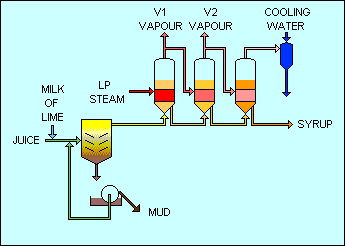How Cane Sugar is Made - Evaporation

The mixed juice from extraction is preheated prior to liming so that the clarification is optimal. The milk of lime, calcium hydroxide or Ca(OH)2, is metered into the juice to hold the required ratio and the limed juice enters a gravitational settling tank: a clarifier. The juice travels through the clarifier at a very low superficial velocity so that the solids settle out and clear juice exits.
The mud from the clarifier still contains valuable sugar so it is filtered on rotary vacuum filters where the residual juice is extracted and the mud can be washed before discharge, producing a sweet water . The juice and the sweet water are returned to process.
The clear juice has probably only 15% sugar content but saturated sugar liquor, required before crystallisation can occur, is close to 80% sugar content. Evaporation in a steam heated multiple effect evaporator is the best way of approaching the saturated condition because low pressure water vapours can be produced for heating duties elsewhere in the factory.
The evaporator sets the steam consumption of the factory and is designed to match the energy balance of the entire site: the manager wants to avoid burning auxiliary fuel and equally wants to avoid paying to dispose of surplus bagasse. The greater the number of effects, the less steam is required to drive the first effect. Each subsequent effect is heated by the vapour from the previous effect so has to be operated at a lower temperature and therefore lower pressure.



| 